Helena Rubinstein
Continued to: Helena Rubinstein (1915-1930)
Any discussion of the early life and business dealings of Chaja (Helena) Rubinstein suffers from a lack of reliable information and a great deal of dissembling by Rubinstein herself. Patrick O’Higgins – who worked as Helena Rubinstein’s personal secretary almost continuously from 1951 to her death in 1965 – quotes Rubinstein herself saying, “Good publicity doesn’t need too many facts!” (O’Higgins, 1971, p. 145).
Rubinstein was born Chaja (Chaje) Rubinstein in 1872 in Podgórze, now part of Kraków, Poland. However, her parents Gitel [1844-1911] and Hersz [1849-1911] Rubinstein moved to Kazimierz, Kraków soon after she was born and this is where her birth was registered (Banasik, 2023, p.16). Rubinstein would later elevate her family’s financial and social standing as well as the level of education she received in Poland. Her parent’s plan for Helena was most likely limited to securing her a suitable husband and an argument about an unsuitable match may have been the reason she was shipped off to Australia in 1896.
Australia
After disembarking in Melbourne, Rubinstein travelled to Coleraine in country Victoria to stay with her uncle Bernard who ran a general goods store there (Woodhead, 2003, p. 38). However, she appears to have been back in Melbourne by 1901, lodging in a boarding house run by Elizabeth Stern in Grey Street, St. Kilda while earning a living waitressing at the Café Maison Dorée in Swanston Street, a Melbourne restaurant founded by Josephine Lacaton [1843-1900].

Above: c.1900 Elizabeth Street, Melbourne. At the time, Melbourne was the largest city in Australia, with an estimated population of 496,000. It had become very wealthy due to the Victorian gold rush of the 1850s and 1860s.
Rubinstein’s career in the beauty business began in 1902 when she opened her first beauty salon in the O’Connor Building at 138 Elizabeth Street, Melbourne. The building, somewhat modified, still stands today. Early in 1903, she began advertising a range of beauty products through local newspapers including ‘The Age’, ‘The Argus’ and ‘Table Talk’. The Elizabeth Street salon did well and the following year she moved to larger quarters at 243 Collins Street.
James Henry Thompson
The step up from waitress to salon owner required capital. Rubinstein claims to have borrowed £250 from an untraceable Miss MacDonald, Rubinstein said she had met on-board ship when coming to Australia. However, her most likely backer was James Henry Thompson, the general manager of the Robur Tea Company.
When Rubinstein visited Australia in 1958, and was staying at the Menzies Hotel in Melbourne, she was visited by an Abel Isaacson who claimed to have known her from her early days in Melbourne. As O’Higgins reports, Isaacson outlined the importance of Thompson to Rubinstein in the establishment of her beauty business.
“Without Mr. Thompson—he was the manager of the Robur Tea Company—the Madame wouldn’t have done what she did. He helped her . . . . He taught her . . . . He made her! Mark my words, he was the brains behind the little lady.
(O’Higgins, 1971, p. 150)
Thompson had the experience and contacts to help Rubinstein set up her business and to deal with the paperwork required to establish Helena Rubinstein & Co and its associated trademarks. Her command of English was not good so he may also have helped her compose some of her early advertisements. It is even possible that he came up with the name Valaze with which she branded many of her early products. Her debt to him might explain why advertisements for Robur tea were included in a number of her early booklets.
How Thompson came to know Rubinstein is an open question but it is possible that he met her as a customer of the Café Maison Dorée and that a romantic relationship may have developed between them.
Felton, Grimwade & Co.
Rubinstein also needed beauty products to sell. Her initial range of beauty products included a face cream called Valaze, a soap, a face powder, a skin lotion (for powder) and a hair tonic. Rubinstein claimed that these were created by and imported from a noted skin specialist by the name of Dr. Lykuski, who made them using herbs growing in the Carpathian mountains. Dr. Lykuski, or Lykusky, appears to have been another Rubinstein invention. She changed the origin story of the origin of Valaze many times and, by 1930, had added an actress to the tale and given Dr. Lykusky a brother.
[Valaze] was a preparation which had been first introduced to us by the famous Polish actress Modjeska. The formula for this cream had been discovered by the brothers Lykusky who had supplied us with it for a personal use ever since I was a little girl. Naturally enough, I was quite frank in crediting the cream for my own flawless complexion.
(Rubinstein, 1930, p. 12)
In another version of the story, Rubinstein claimed that Dr. Lykusky later visited her in Australian and gave her all of his recipes so she could make them up in her ‘kitchen’, a laboratory attached to her salon.
I decided to write to Dr. Lykusky, asking him to come to Australia to work with me. To my delight he accepted, agreeing to stay for a short time. In fact, he remained many months, teaching me to formulate the original cream which we christened Crème Valaze. … We also formulated several related cleansing creams, astringent lotions and a medicated soap, so as to have a complete line.
(Rubinstein, 1965, p. 27)
It seems more likely that all of Rubinstein’s cosmetics were commercially manufactured in Melbourne. The probable source was Felton, Grimwade & Co., a large chemical wholesale and manufacturing company established in Melbourne in 1867. F. S. Grimwade of Felton, Grimwade & Co. knew Rubinstein well enough to put his name on her 1907 naturalisation papers which made her a citizen of Australia (Woodhead, 2003, p. 48).
Felton, Grimwade & Co. had also established the Melbourne Glass Works in 1872 – the forerunner of Australian Glass Manufacturers Ltd. – and Rubinstein may have sourced her glass containers from them. So, although Rubinstein worked very hard in her salon after hours, in all probability these labours consisted of filling and labelling bottles and jars with creams and lotions made by Felton, Grimwade & Co. and doing the day-to-day jobs associated with running a salon and a business.
Valaze
The signature line of Helena Rubinstein’s Melbourne salon was Valaze, a cream that Rubinstein said could ‘improve the worst skin in one month’. It remained in her inventory for decades under a range of names including Valaze Beautifying Skinfood, Skin Clearing Cream, and Wake-up Cream.

Above: Close-up of the Valaze label from the trademark application. It reads: “Valaze. Usuwa zmarszczki, piegi, liszaje. Nadaje twarzy delikatna blatose przezrozrystose” which translates as: “Valaze. Removes wrinkles, freckles, lichens. Gives the face a delicate pallor, transparency” (Personal communication). The language mistakes and lack of diacritics suggest the label was printed in Australia. Helena probably included the Polish text to convince clients that the cream was imported.
What is Valaze?
A recently introduced and most delightful preparation for the skin is creating quite a little mild sensation among Melbourne society women, many of whom have recently discovered the great improvement which quickly results from its use.(Rubinstein advertisement, 1903)
As previously noted, Rubinstein claimed that Valaze contained herbs from the Carpathian mountains but O’Higgins reports that when he was shown the original formula for Valaze, a few months before Rubinstein died, that it was nothing special.
There was no mention of rare herbs, Oriental almonds, or the bark of an evergreen tree! The formula listed a variety of common garden raw materials such as ceresine wax, mineral oil, sesame.
(O’Higgins, 1971, p. 151).
Unfortunately, O’Higgins does not give us a full list of the ingredients written down on the slip of paper handed to him by Rubinstein, nor can we be certain that this was the original recipe.
All of the ingredients listed by O’Higgins were used in the manufacture of cold creams. Woodhead (2003) suggests that ceresine wax was an unlikely cold cream ingredient but this was not the case. This odourless, mineral substitute for beeswax has a relatively high melting point and also reduces the sweating (bleeding) of liquid oils in emulsions (deNavarre, 1941, p. 89), both qualities that would have helped stabilise a cold cream in a hot climate like Australia.
Another possible ingredient in the original Valaze formulation was lanolin. Cosmetic grades of lanolin had been used in Germany from 1880 (Sagarin, 1957, p. 116) and had been promoted in the medical profession by the German pharmacologist Professor Oscar Liebreich [1839-1908]. Its use was so commonplace by 1900 that a Melbourne newspaper even included it in a recipe for a home-made cold cream.
Cold Cream for the Face.—Take 20 grains of powdered gum-arabic, 1 oz. of pure white vaseline, ½ oz. of pure lanoline and ½ oz. of rosewater. Beat up the gum-arabic with a little of the rosewater. Then add, by degrees, first a little of the vaseline, then a little of the lanoline, then more rosewater, and so on, till the whole is beaten to a smooth cream. This cream is invaluable to those whose faces are inclined to be rough and crack when east winds visits us. It should be well rubbed into the skin after the night’s wash.
(“Toilet hints,” 1900)
Lanolin was widely regarded at the time as the closest substance to sebum and the best skin food. Its presence may have been the reason why Rubinstein referred to Valaze as a skin food in ‘the truest sense of the word’.
[Valaze] is in the truest sense of the word a “skin food.” When rubbed into the skin it is absorbed into the pores, and creates a perfectly healthy condition. By its aid all impurities are removed, and the skin becomes re-invigorated. for the first application or two, if the skin has been in a bad state, the results may be discouraging, for it throws off all impurities to the surface, but almost immediately the good results are seen.
(Rubinstein advertisement, 1903)
See also: Skin Foods
Rubinstein repeatedly insisted that Valaze was capable of removing pigmentation problems such as freckles.
In the matter of removing freckles the Russian Skin Food Valaze fully deserves to be termed a specific. It does not cover them up in French fashion, but removes them beyond all peradventure. To accomplish this, and relieve tan and sunburn, Valaze should be applied more thickly than usual.
(Helena Rubinstein, c.1908, p. 16)
Unfortunately, the freckle-removing ingredient in Valaze is unknown to me. Rubinstein described Valaze as ‘skin-stimulating’ as well as ‘skin-feeding’ which will ‘improve the worst skin in one month’. As the improvement took time this suggests that Valaze contained an exfoliating lightener and/or a mild chemical bleach.
Return to Europe
In 1905, with her business doing well, Rubinstein travelled back to Europe looking for new products and treatments to introduced to her Australian clients. On her return to Melbourne she gave a report of her trip in an interview published as an advertorial in ‘Table Talk’. This included a description of her new salon in the Glen’s Building at 274 Collins Street, now called the Valaze Massage Institute.
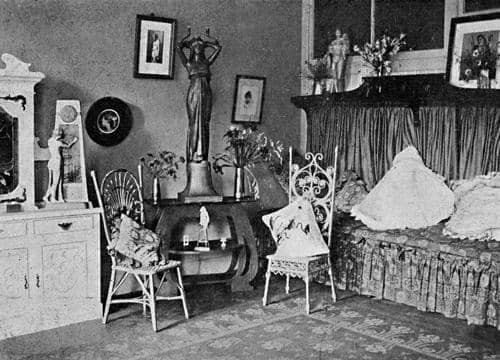
Above: 1905 Reception of the Valaze Massage Institute in the Glen’s Building at 274 Collins Street, Melbourne, decorated with objects Rubinstein bought back from Europe. The carpet and walls were in green tones, the wicker furniture was gilded and the wooden cabinet was painted in white enamel.
In the interview, Rubinstein noted that her new salon was now staffed by two Viennese experts who were actually Rubinstein’s sister Céska and her cousin Lola. They were not ‘Viennese experts’ nor was one medically educated as Rubinstein suggested. In all likelihood their training was limited to what Helena could impart to them on the long ship voyage to Melbourne.
Rubinstein then went on to describe how she had trained with Dr. Pashki of Vienna, Professor Lasaar of Berlin, Dr. Pokitonoft in Paris and Dr. Una in Hamburg while away. I think she is referring to Dr. Heinrich Paschkis [1849-1923], Professor Oskar Lassar [1849-1907], Dr. Catherine Sophie Mathilde Pokitonoff [1856-1927], and Dr. Paul Gerson Unna [1850-1929]. Whether she actually met all of these eminent individuals during her European tour is an open question. Her most likely face-to-face meeting was with Dr. Mathilde Pokitonoff (née von Wulfert) who was based in Paris. Pokitonoff’s daughter, Vera [1883-1967] was married to Robert Bienaime [1876-1960], one of the owners of Houbigant (Personal Correspondance, 2017). Rubinstein could have ‘trained with’ the others by reading what they had written.
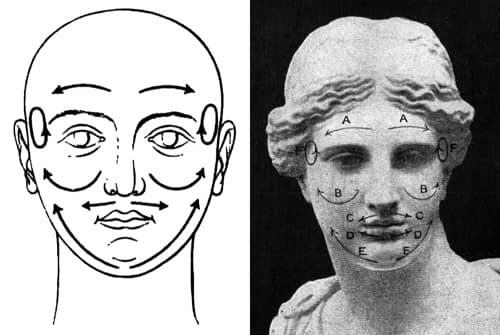
Above: Facial massage movements. Left: Paschkis (Paschkis, 1905). Right: Rubinstein (Helena Rubinstein, c.1908). The resemblance suggest that Rubinstein’s uncredited source for her massage movements was Paschkis.
Rubinstein also described visits to a number of European beauty salons and all the leading establishments in London. This suggests that, along with an assortment of French salons, Rubinstein also saw how things were done at Cyclax, Mrs. Pomeroy, and Eleanor Adair.
See also: Cyclax, Mrs. Pomeroy and Eleanor Adair
Along the way, Rubinstein bought equipment that allowed her to introduce a number of new skin treatments into her Melbourne salon, many of which were potentially dangerous.
The most innocuous of these was a roller massager, the Valaze Massagette, made with little, rounded-ended teeth constructed from ivory or bone. Rubinstein used massage in her salon treatments and had included instructions on how to do a facial massage at home in her first published booklet, ‘The guide to beauty’ (1903). Selling the roller through her salon gave Rubinstein a way to monetise the practice of face massaging by suggesting that it was superior to procedures done by hand.
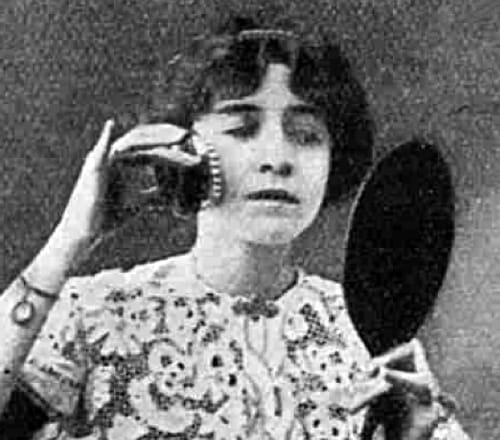
Above: 1913 Valaze Massagette.
As to face massage, while the doctors all agreed that hand massage is very good when properly and scientifically applied, they say it is so seldom that it is properly done that now in general cases they always recommend roller massage. Yes, I brought the rollers out with me; these are they, and it is wonderful the improvement they work in a very short time. Of course there are cases where hand massage is necessary, and we then use it. But the doctors discourage it generally, because unless properly applied it really does more harm than good.
(“A beauty institute,” 1905)
By 1914, Rubinstein was also selling an electric massager which she recommended for body massage and for treating a range of conditions including obesity, rheumatism, sciatica, circulation problems, lumbago, indigestion and fatigue. Fatigue has been used as a euphemism for other things and Woodhead believes that Rubinstein’s Massage Electro-Vibratoire was involved in more ‘intimate’ treatments in her Paris salon (Woodhead, 2003, p. 90). I have only found French advertisements for this machine so it may have only been sold there.
Also fairly innocuous was a new vacuum-suction treatment to remove wrinkles, and electrolysis to treat superfluous hair, warts and other blemishes.
See also: Vacuum Suction and Electrolysis
By 1908, Rubinstein also had a depilatory in her product line called Novena Hair Destroyer. She claimed that it did not contain hydrosulphate of sodium, hydrosulphate of lime, barium sulphide, orpiment or yellow trisulfide of arsenic as these were all poisonous. It is possible that she used strontium sulphate as the active agent as the Jacques Perl’s patent would have lapsed by then.
See also: Chemical Depilatories
More dangerous were her red nose treatments, originally developed by Dr. Oskar Lassar [1849-1907] to treat rosacea and rhinophyma, and her injections of paraffin wax to fill up wrinkles and hollows in the face and neck.
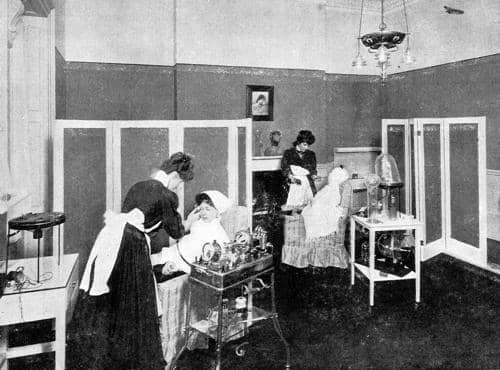
Above: c.1908 Treatments at the Maison de Beauté Valaze, London. Red nose treatment in the foreground and special treatment for wrinkles in the background which involved bandaging and the use of a vacuum suction machine.
See also: Rubinstein and Red Noses, Vacuum Suction and Straps, Bandages and Tapes
As with the removal of superfluous hair, Rubinstein would later add a cosmetic to help reduce redness. Her Novena Red Nose Ointment could be applied at night and face powder could be used to cover redness during the day.
In the 1905 interview with ‘Table Talk’ Rubinstein also made mention of face peeling. As far as I can tell this treatment was not conducted in Australasia but it does appear to have been available in her London salon when it opened in 1908.
Rubinstein also outlined a number of new cosmetics she had brought back from Europe. As well as Dr. Lykuski Black-head Cure there was a liquid powder called Comtesse Potocka’s Creme Promenade, and Voskpasta.
Comtesse Potocka’s Creme Promenade: “[A]n exquisite skin emollient, specially suitable for use before indulging in out of door exercise and before balls, evenings, concerts and the like. It prevents excessive perspiration, and quite obviates that flushing and redness of the hands and face that so upsets the most carefully prepared toilet”.
Voskpasta: “[C]orrects faulty secretion of the skin and restores wasted tissues, increasing also the muscular tone. At the same time it removes the thrown-off waste of the skin, keeping the pores free to perform their function of unimpeded respiration.”
Comtesse Potocka’s Creme Promenade may have been named after the Countess Emanuela Potocka née Emanuela Pignatelli [1852-1930] an Italian-Polish noblewoman and fashionable salonière in Paris. I doubt that Rubinstein garnered permission to use her name.
Rubinstein credits Voskpasta to Professor Schleich – Carl Ludwig Schleich [1859-1922] a German surgeon – so it was most likely a copy of Schleich’s wax paste or pasta cerata. Rubinstein recommended that it be used daily after the skin had been cleansed with Novena Soap or Valaze Herbal Soap.
Scheich’s wax paste. Yellow beeswax, 90; KOH, 3.5; water 150. Heat together and agitate until a homogeneous mass results. Allow to stand for two days, then beat into a paste in a mortar. It forms an excellent basis for dermatological use and forms an occlusive aseptic dressing.
(Braithwaite, 1909, p. 140)
Expansion
The arrival of two family members in Melbourne meant that Rubinstein could now expand her business. Her products were available across much of Australia but Melbourne was her only beauty salon. In 1906, she opened a second salon at 158A Pitt Street, Sydney above the druggists Washington H. Soul – the building still stands today – and also began selling her products in New Zealand, opening a third salon there at 9 Brandon Street, Wellington in 1907.
By this time Rubinstein had met and become involved with the Polish-born, American journalist Arthur Ameisen [1870-1951] who had changed his name to Edward William Titus. Like Rubinstein, Titus was Jewish. The couple met in Melbourne or Sydney in 1905 or 1906 and would eventually marry in London. Titus was responsible for much of the marketing and publicity material written for Rubinstein as she expanded her cosmetic business in Australasia and beyond, including her ‘Beauty in the Making’ booklets which began to appear around 1908.
Rubinstein returned to London in 1908 and married Titus in a registry office in the Strand. She also took out a lease on a Georgian town house at 24 Grafton Street, Mayfair, and set about turning it into a Maison de Beauté Valaze.
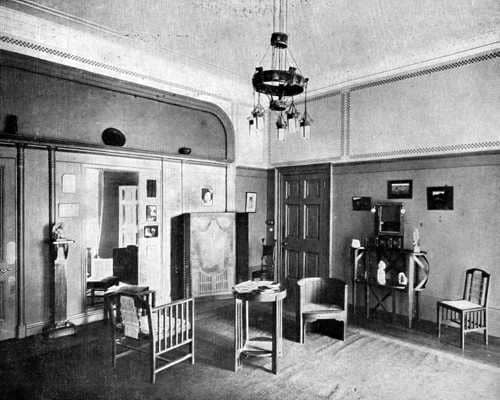
Above: Waiting room at the Maison de Beauté Valaze at 24 Grafton Street, Mayfair.
In 1909, Rubinstein opened a Maison de Beauté Valaze at 255 Rue Saint-Honoré, Paris. It appears to have been based on an existing beauty business Rubinstein said she had bought from a Madame Champbaron.
The House of Champbaron was founded in Paris in 1876 by Jean Bourdieu. It underwent a number of changes of address, moving from 30 Rue de Provence to 10 Rue Laffitte before reaching 7 Rue Theodore de Banville in 1907 (Personal Correspondance, 2017). Throughout its history there is mention of a Géorgine Champbaron and the firm made a Crème Géorgine but lost the name in 1884 in a trademark dispute with a Madame Dupoty, who sold a Crème Géorgienne and Poudre Géorgienne (Pataille, 1884).
In 1909, the Champbaron salon was situated in a palatial set of rooms on the first floor of 364 Rue Saint-Honoré run by someone who called herself Madame Georgine de Champbaron (‘La ville lumière,’ 1909, p. 51) – the Madame Champbaron mentioned by Rubinstein – who may have been a new owner of the business.

Above: 1909 Reception room at the Maison d’Hygiène et de Beauté de Mme Georgine de Champbaron at 364 Rue Saint-Honoré, Paris.
Rubinstein established her Paris salon at 255 Rue Saint-Honoré not at 364 so it would appear that her main aim in purchasing the business was the product range not the palatial salon.

Above: c.1914 Waiting room at the Maison de Beauté Valaze at 255 Rue Saint-Honoré, Paris. The woman on the right is Helena Rubinstein.
Rubinstein also opened up a small factory in St. Cloud which may have been acquired as part of the purchase of Champbaron.
Skin-care
Like other Beauty Culturists in the early part of the twentieth century, Rubinstein’s skin-care preparations were centred on remedies for specific skin conditions such as dry and greasy skin, freckles, tan and sunburn, blackheads, and wrinkles. In addition, she had treatments for general problems such as superfluous hair, bust development and excess flesh, some of which, such as Dr. Rukinoff’s Blood Producer, would be considered patent medicines.
Dr. Rukinoff’s Blood Producer: “[T]hey build up good and durable blood-making material and supply the sinews of war [sic] against disease.”
See also: Patent Medicines and Cosmetics
Soap and water
Rubinstein did not hold strong views on the use of soap but agreed that it might be detrimental for individuals with tender or fair complexions.
There are, as is well known, individuals who have such tender skins that even the mildest soap would work them an injury.
(Rubinstein, c.1908, p. 21)
Clients whose skin was too tender to use Dr. Lykuski’s Valaze Herbal Soap or Novena Complexion Soap (containing 20% Voskpasta), were recommended to use Daleihne, a cleansing lotion, Dr. Lykuski’s Valaze Skin Tonic, which could be added to water, or to cleanse the skin with Valaze Skin Food or use Novena Cerate, a type of cold cream introduced in 1908.
Novena Cerate: “[T]he most effective and natural skin cleanser known. … [A]llays irritation by abstracting all heat from the cuticle. It is a source of delightful comfort to the face.”
Daleihne: “[F]or such super-sensitive skins as rebel against the use of all soaps. … Under its balmy action the skin remains delightfully humid, soft and smooth, and is proof against wrinkles.”
Massage
Rubinstein subscribed to the idea that massage would improve circulation and could be used to build up or reduce flesh depending on how it was used, both common ideas for the time.
To restore the contour of features, to retrace lovely curves, which over-development of tissue has blurred, are among its aims. Massage will also bridge-over, round out and fill out furrows, hollows and angles of exaggerated severity on the face, and will do this by developing and bringing back the subcutaneous fat. It can build up or destroy, according to its application.
(Rubinstein, c.1908, p. 31)
See also: Massage, Wrinkles and Double Chins
Although Rubinstein conceded that a professional masseuse could achieve wonders, and gave instructions for the correct way to do a hand face massage at home, she recommended that clients use her previously mentioned mechanical roller to remove wrinkles, or reduce double chins and excess flesh at home. In the case of double chins, the roller treatment was accompanied by the use of a Valaze Double Chin Strap.
Massage is a great help and a great factor in dissipating, destroying and absorbing growth of tissue, the excess of which means a double chin. But massage alone is not sufficient in this case. The fat having been driven away from under the skin by massage with the Valaze Rollers, the void needs to be levelled, the muscles demand strengthening, the tissues must be braced and must be held permanently in place and check. This is accomplished with brilliant success by my Valaze Double Chin Strap, which has been devised on accurate anatomical lines, and which not only exerts and effective massage by continued well-regulated pressure, but gives all necessary support to the muscles of the chin, cheeks and neck.
(Rubinstein, c.1908, p. 33)
Skin types
Rubinstein classified skin into normal, dry, and greasy or moist. However, as she concentrated more on skin problems rather than skin maintenance, most of her treatment advice went to correct dry or greasy skins.
Rubinstein suggested that dry skin was brought about by insufficient natural lubricants, a condition that could be exacerbated by the use of harsh alkaline soap, alcohol preparations such as Eau de Cologne, as well as extremes of weather such as frost, dry winds or excessive heat. For moderately dry skin Rubinstein recommended Dr. Lykuski’s Russian Skin Food Valaze at night and Novena Cerate during the day, although her position on this was not fixed. For very dry skin she suggested spreading the creams on thickly and leaving them on the surface without rubbing them in.
Valaze: “[P]erfects the good skin, purifies the bad skin, and beautifies all skin. Valaze preserves the complexion in freshness and pure flesh-tint.”
Novena Cerate: “[T]he most effective and natural Skin Cleanser known. … Novena Cerate is absorbed by the pores with the greatest ease; it sinks to a remarkable depth, far below the outer surface of the skin and builds up wasted tissue with remarkable rapidity.”
Greasy skin was due to an over-secretion of oils which Rubinstein counselled should be removed with Valaze Herbal Soap or Novena Complexion Soap, or absorbed with powder. Rubinstein sold two powders: an absorbent Valaze Herbal Powder, and Novena Poudre, a type of ‘fettpuder’ made with 20% Novena Cerate.
Valaze Herbal Powder: “[A] dainty, pure, and unobtrusive associate of the Valaze Skin food.” Shades: Flesh, White, Pink, and Cream.
Novena Poudre: “[T]he only complexion powder which is a Skin Food as well. It causes the skin beneath it to become succulent, firm and supple, and to gain rapidly in sap and beauty.” Shades: Flesh, White, Pink, and Cream.
In addition to these powders, Rubinstein recommended Novena Pasta as an outdoor speciality for greasy skins. It came in two shades and could be applied to the neck, shoulders and arms to produce an alabaster tone. Described as a skin-care product it was more akin to a liquid body powder.
Novena Pasta: “[P]reserves, cools, refreshes and nourishes the most oily or greasy skin and instantly whitens it. The beautiful whiteness of skin … cannot be dislodged even by persistent perspiration, but continues for hours.”
See also Liquid Face Powders
Rubinstein did not give up on the idea that her Valaze cream could be used on all skin types but introduced a non-greasy variant called Valaze Special as an alternative in 1909. I imagine it was a type of vanishing cream.
Valaze Special: An absolutely non-greasy variant of the wonderful skin food, for day use. When applied it leaves the skin without the slightest trace of oiliness or unctuousness, but presents a lovely white surface.
Lines and wrinkles
Rubinstein considered that most wrinkles were caused by a lack of subcutaneous fat, the cure for which was a skin food – either Valaze Skin Food or Novena Cerate – combined with facial massage. As with dry skin, if the problem was severe, the creams were applied thickly and left on the skin.
For expression lines, Rubinstein recommended the Valaze Forehead Strap worn over a strip of soft linen spread with Valaze Skin Food or Novena Cerate.
The Valaze Forehead Strap not only eradicates all traces of creases and furrows caused by frowning and scowling, but also cures one of the habit of frowning.
(Rubinstein, c.1908, p. 29)
Clients could also use Novena Extrait, astringents being a well-accepted remedy for fine lines and wrinkles as they ‘tightened sagging skin’. Novena Extrait may have been a stronger astringent than Rubinstein’s other preparation, Dr. Lykuski’s Valaze Skin Tonic.
Dr. Lykuski’s Valaze Skin Tonic: “It tones and braces the skin, prevents wrinkles, and in every way makes for healthfulness. Valaze skin tonic may be used either pure or added to water. It is astringent, antiseptic, cleansing, soothing and healing, and the skin responds to its action with astonishing rapidity, showing marked improvement in health colour and charm.”
Novena Extrait: “[E]specially noted for its astringent, soothing and stimulating qualities. It is an anti-wrinkle lotion, the constant use of which is an unfailing safeguard against lines about the eyes.”
See also: Skin Tonics, Astringents and Toners
For deeper wrinkles and furrows there was also Email du Visage. Rubinstein suggested that clients book a personal interview so that its correct use could be explained but was prepared to send explicit instructions by mail of this was not possible. This suggests the product may have been a paste used in the same manner as a facial enamel.
See also: Queen Alexandra and Face Enameling
For really extreme cases, where the lines were very pronounced, Rubinstein recommended a salon treatment that injected paraffin wax into the lines to fill them out. One hopes that she gave this treatment up before too long as paraffin wax injections had a tendency to migrate over time, producing very adverse results.
Blackheads, enlarged pores and acne
Treatments for all of these conditions started with steaming the face with Valaze Aromatic Herbs. This was followed by Dr. Lykuski’s Blackhead and Open Pore Cure for mild cases, with more difficult problems requiring Blackhead Cure No. 2 or Valaze Liquidine.
Dr. Lykuski’s Blackhead and Open Pore Cure: “[E]asily and quickly banishes every trace of this disfigurement. … It closes the enlarged pores, cures a greasy snd coarse skin, and assists in preserving a healthy and beautiful complexion.”
Valaze Liquidine: “[E]liminates every possibility of the face ever being disfigured by blackheads, pimples, over-moist skin, and other impurities. … Acts directly on the pores, freeing them of over-abundant secretions, promotes healthy circulation an skin-breathing, which are so essential to charm of complexion and freedom from wrinkles.”
See also: Vaporisers (Steamers & Atomisers), Blackheads and Enlarged Pores
Freckles, tan and sunburn
Living in Australia made Rubinstein very aware of the damaging effects of the sun. Valaze was recommended for the removal of freckles but Rubinstein also made Novena Sunproof Crème as a sun protectant.
Novena Sunproof Crème: “[E]nables one to go out riding, driving, motoring, golfing, gardening, sea-bathing on hot, tropical days, to deliberately expose one’s face and hands to the sun’s boiling heat, and return home with the skin quite untouched by the sun’s scorching power.”
Flesh reduction and development
In addition to recommending massage, Rubinstein sold a number of flesh-reducing and flesh-developing preparations that could be used to improve the bust or reduce unwanted excess flesh. These included Dr. Rukinoff’s Bust-Developing Dragees, Oriental Flesh Producer, Dr. Rukinoff’s Blood Producer, and Marienbad Flesh-Reducing Tablets, all highly suspect but similar to remedies peddled by others.
See also: Bust Treatments
Make-up
Although Rubinstein promoted her powders as part of a skin-care treatment she was not opposed to the use of paint (make-up) and promoted its use in moderation.
Prejudices are generally groundless. … Deception if you please, but how small and how pardonable.
Let it be admitted that the wise course lies in compromise. In other words, one should not paint unless it becomes indispensable, and even then the colour should be applied with infinite tact and zephyr’s touch. “Make up” should be moderate, simply an accent.(Rubinstein, c.1908, pp. 26-27)
By 1908, as well as the previously mentioned Valaze Herbal Powder, Novena Poudre and Novena Pasta, Rubinstein also sold a lip rouge, a liquid cheek rouge and a face powder made as a lotion. Both the lip and cheek rouges appear to have been indelible. Rubinstein states that the rouge was of herbal derivation so it may have been coloured with a cheaper dye like alkanet rather than the more expensive cochineal.
Valaze Lip Lustre: “[A] highly effacacious lip-food, and the colouring it imparts cannot be displaced even by bitting or wetting.”
Valaze Rouge Tenace: “[A]mirably suitable for all skins. Its chief virtue is its subdued persistence. Even perpiration will not dislodge it … applied with cotton wool, it defies scrutiny.”
See also: Rouge
The liquid face powder came in three shades and was designed to add a little colour to complexions that looked sallow.
Valaze Snow Lotion: “Its ingredients soothe refresh, and cool. … It adheres firmly, and is necessary to apply only a very small quantity, in order to invest the face with an exquisite softness of colour.” Shades: White, Pink, and Cream.
In 1907, Rubinstein introduced some make-up products for the eyes including an eyebrow crayon, kohol and a cake mascara. Contrary to what may later have been said, these could not have been inspired by Sergei Diaghilev’s [1872-1929] Ballets Russes as its first touring season in Paris was in 1909.
Valaze Eyebrow Crayon: “[E]specially adapted for the beautification of the eyes and for the aesthetic accentuation of any of their parts.” Shades: Black, and Brown.
Kohol Jet Grains: “[D]arkens the eyelashes and eyelids, and enhances the eyes. A ‘Merueud’ or ivory stick, to apply the grains, goes with each bottle.”
Valaze Tablette Indienne: “[A]pplied with a soft brush, and is intended to emphasize and extend eyebrow arches, as well as delicately darken the eyelids and eyelashes.”
As well as these eye make-up lines Rubinstein also produced an eye salve.
Novena Eye Salve: “[R]emoves redness of eyelids, stays falling of eyelashes and eyebrows, and promotes their growth.”
America
In 1912, Helena and Edward made Paris their home leaving her sister Mańka to manage the London salon. By then Rubinstein had two children; Roy (b.1909) and Horace (b.1912). Marital problems and the start of the First World War were apparently behind her decision to put her sister Paulina in charge of the Paris salon and to sail New York in 1914, leaving Titus and her two children behind in Paris.
Rubinstein had been making inroads into the American market well before she set up her first salon in 1915. She had been advertising in New York newspapers for a number of years, targeting women making trips to London. In 1911, she also started advertising in American Vogue, perhaps to entice American clients going to London for the ‘coronation season’, the first season after the crowning of King George in 1910. In addition, her Valaze Skin Food and Beautifier was also available to the citizens of New York through Miss Kate Simpson, 78 West 94th Street, New York from as early as 1910. Despite this, Rubinstein was largely unknown in the city, unlike Elizabeth Arden [1881-1966] who had been operating a salon there since 1910. Rubinstein’s arrival in New York marked the beginning of the feud between the two women.
See also: Elizabeth Arden
Timeline
| 1902 | Salon opened at 138 Elizabeth Street, Melbourne. |
| 1903 | Valaze trademarked. |
| 1904 | Melbourne salon moves to 243 Collins Street. |
| 1905 | Melbourne salon moves to 274 Collins Street, Melbourne, now called the Valaze Beauty Institute. New Products: Special Blackhead and Open Pore Cure; Comtesse Potocka’s Creme Promenade; and Voskpasta. |
| 1906 | Salon opened at 158 Pitt Street, Sydney. Products available in New Zealand. |
| 1907 | Salon opened at 9 Brandon Street, Wellington, New Zealand. New Products: Valaze Rouge Tenace, Valaze Lip Lustre; Valaze Eye Crayon; Valaze Tablette Indien; Kohol Jet Grains; Marienbad Flesh-Reducing Tablets; Oriental Flesh Producer; and Dr. Rukinoff’s Blood Producer. |
| 1908 | Salon opened at 24 Grafton Street, London. New Products: Novena Cerate; Valaze Snow Lotion; and Valaze Liquidine. |
| 1909 | Helena Rubinstein Ltd. established (Australia) which then acquires Helena Rubinstein & Co. Acquires the House of Champbaron, Paris; Salon opened at 255 Rue Saint-Honoré, Paris. New Products: Valaze Speciale. |
| 1913 | New Products: Valaze Acne Soap. |
First Posted: 18th September 2017
Last Update: 17th April 2023
Continued to: Helena Rubinstein (1915-1930)
Sources
A beauty institute. (1905, December 28). Table Talk, p. 84
Banasik, K. (2023). First lady of beauty: The Helena Rubinstein Story. The Galitzianer. 30(1), March, 15-20.
Braithwaite, J. O. (1909). Year-book of pharmacy. London: J. & A. Churchill.
Fabe, M. (1972). Beauty millionaire. The life of Helena Rubinstein. New York: Thomas Y. Crowell Company.
Helena Rubinstein. (c.1908). Beauty in the making [Booklet]. UK: Author.
Keil, R. (1981). Collecting Australian pot lids. Port Pirie, SA: Automatic Printing Co. Ltd.
La ville lumière. Anecdotes et documents historiques, ethnographiques, littéraires, artistiques, commerciaux et encyclopédiques. (1909). Paris.
O’Higgins, P. (1971). Madame: An intimate biography of Helena Rubinstein. New York: The Viking Press.
Paschkis, H. (1905). Kosmetik für ärtze. Vienna: Alfred Hölder.
Pataille, J. (1884). Annals de la propriété industrielle artisique & littéraire (Vol. XXIV). Paris.
Rubinstein, H. (1930). The art of feminine beauty. New York: Horace Liveright, Inc.
Rubinstein, H. (1965). My life for beauty. Sydney: The Bodley Head Ltd.
Sagarin, E. (Ed.). (1957). Cosmetics: Science and technology. New York: Interscience Publishers, Inc.
Toilet hints. (1900, July 14). Leader, p. 39.
Woodhead, L. (2003). War paint. Miss Elizabeth Arden and madame Helena Rubinstein their lives, their times, their rivalry. London: Virago Press.

Chaja (Helena) Rubinstein [1872-1965].

Standing: Mania, Chaja, and Cypora Rubinstein. Sitting: Estera, and Gitel Rubinstein. All Rubinstein’s sisters also underwent name changes: “Perel became Paulina; Rachel became Rozalia; Rywka became Regina; Sara became Stella; Cypora became Cecylia and then Ceśka (a typical Polish diminutive); Manya became Mania and then Mańka; and Estera became Erna” (Banasik, 2023, pp.16-17).

James Henry Thompson [1864-1933].
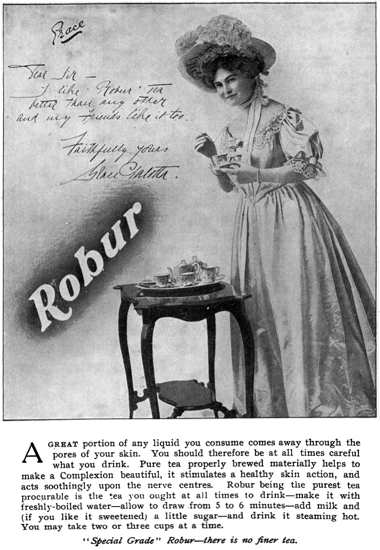
Robur Tea advertisement featuring the actress Grace Palotta [1870-1959] that appeared in Helena Rubinstein’s ‘Beauty in the Making’ booklet (c.1908).
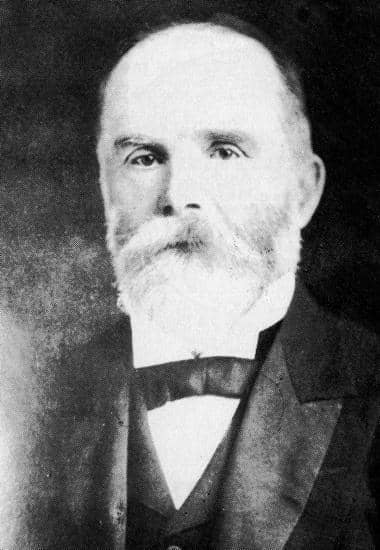
Frederick Sheppard Grimwade [1840-1910].
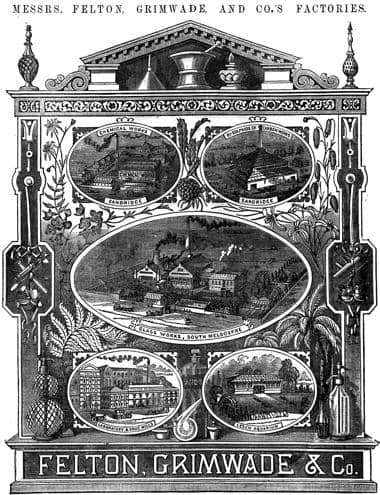
1884 Felton, Grimwade & Co.
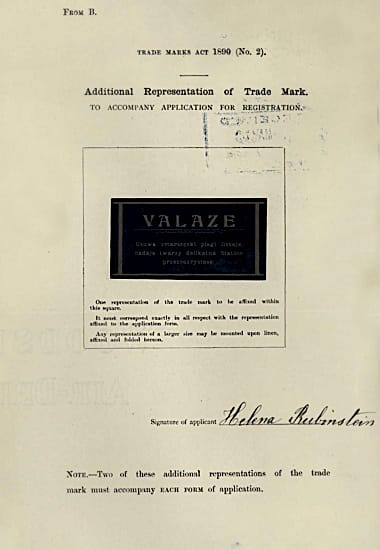
1903 Part of the Australia trademark application for Valaze (National Archives).
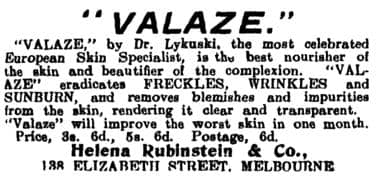
1903 Valaze. Helena Rubinstein & Co., 138 Elizabeth Street, Melbourne.
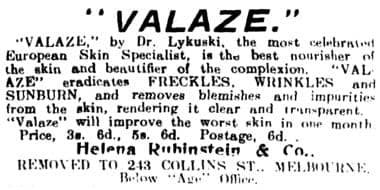
1903 Valaze. Helena Rubinstein & Co., 243 Collins Street, Melbourne.
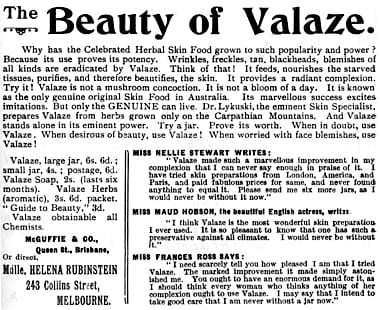
1905 Valaze endorsements from Nellie Stewart, Maud Hobson and Frances Ross. Nellie Stewart was Helena Rubinstein’s first celebrity endorsement.

1905 Valaze Skin Food. Also Valaze Herbal complexion Soap, Valaze Skin Lotion (a la pudre), Valaze Face Powder and Valaze Skin T onic.

1905 Valaze. Also Valaze Soap, Valaze Herbs (aromatic), Valaze Skin Tonic and Valaze Face Powder.

c.1921 Edward William Titus [1870-1951], born Arthur Ameisen.

1905 Valaze Massage Institute at 274 Collins Street, Melbourne. By this time Edward Titus was writing Rubinstein’s advertising copy.
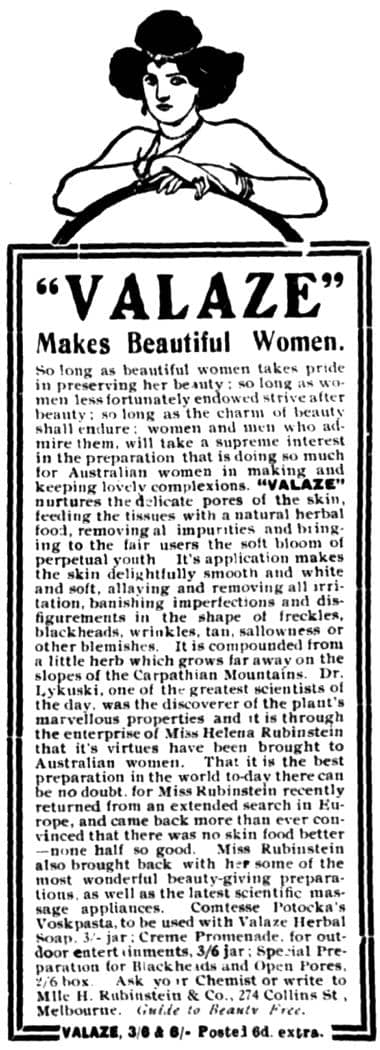
1905 Valaze.

1907 Why Valaze makes the skin so beautiful.
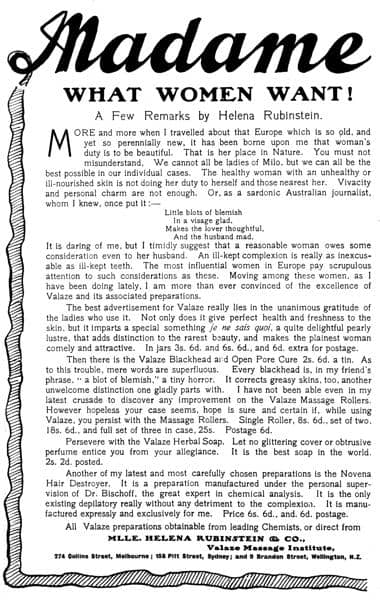
1908 Valaze Massage Institute.

1910 Helena Rubinstein Complexion Treatments.
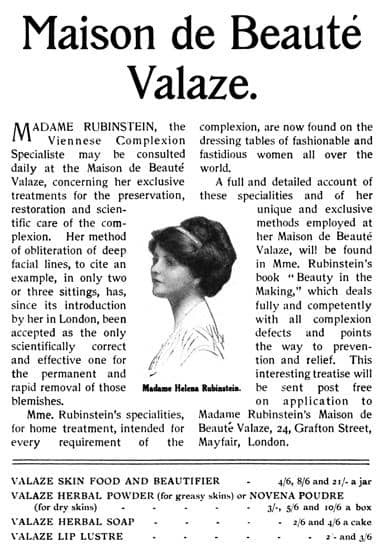
1910 Maison de Beauté Valaze.
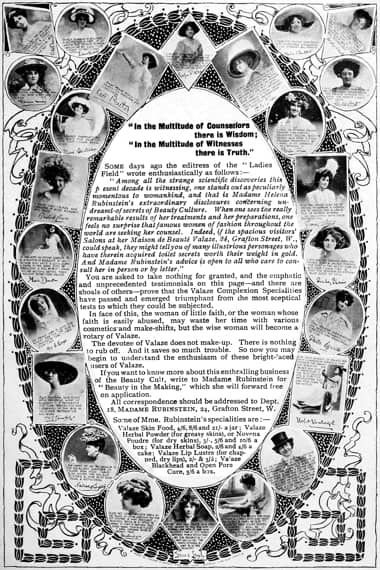
1910 Helena Rubinstein endorsements.
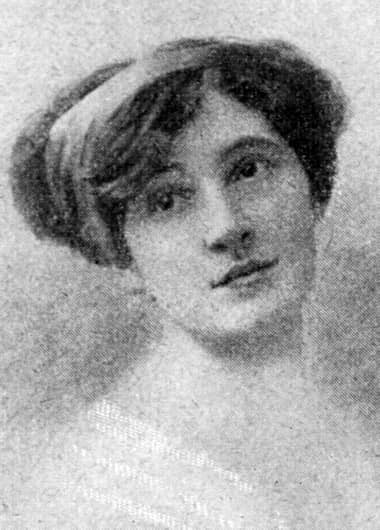
1911 Ceśka Rubinstein [1883-1967]. She arrived in Australia in 1905 and was left in charge of the Australasian business when Helena moved to London in 1908. She became an Australian citizen in 1916 to avoid being classified as an enemy alien by the Australian authorities during the First World War (Woodhead, 2003).

1911 Helena Rubinstein, advertising to Americans traveling to London.
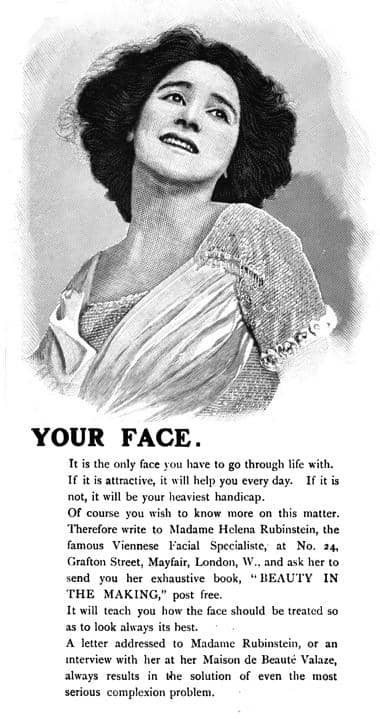
1911 Valaze. Rubinstein is promoting herself as a Viennese Facial Specialist. When war broke out in 1914 she would switch to being Russian.

1912 British trade advertisement for Valaze.

1912 Helena Rubinstein (France).
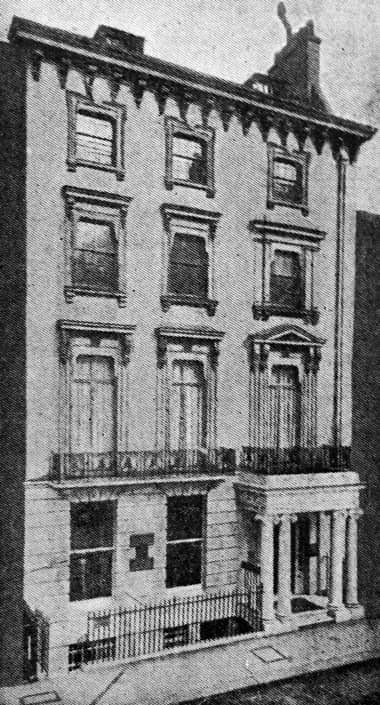
c.1923 The Maison de Beauté Valaze at 24 Grafton Street, Mayfair. The salon would remain here until the building was bombed during the Second World War.
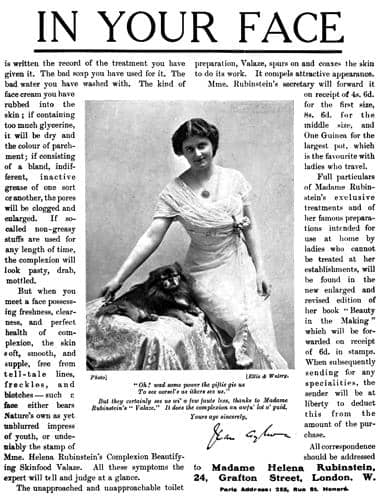
1913 Madame Helena Rubinstein’s Complexion Beautifying Skinfood Valaze (London).

1913 Helena Rubinstein.
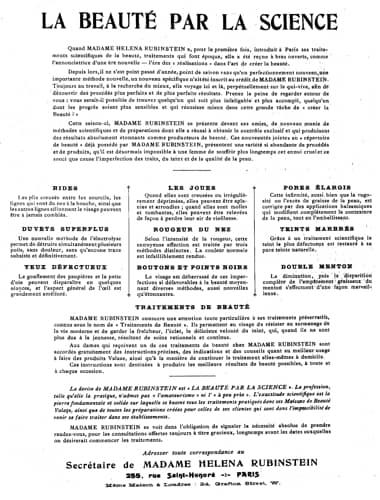
1913 Helena Rubinstein (France).
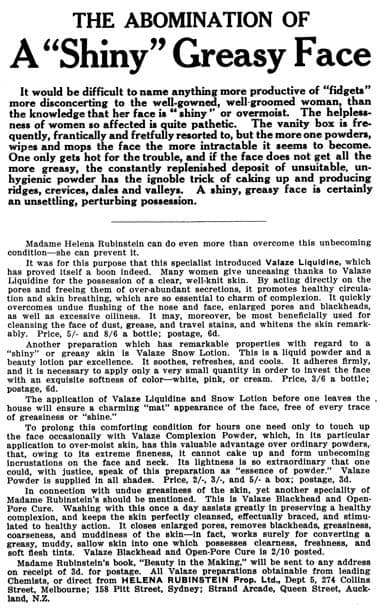
1913 Helena Rubinstein. The New Zealand salon has moved to the Strand Arcade, Queen Street, Auckland.

1913 Helena Rubinstein make-up lines.

1913 Helena Rubinstein Novena Sunproof Crème.

1914 Helena Rubinstein Valaze (France).
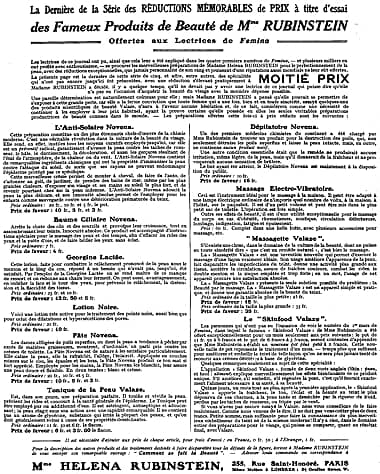
1914 Helena Rubinstein Produits de Beauté including the Massage Electro-Vibratoire (France).
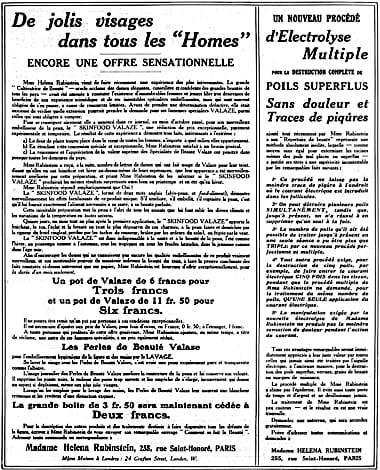
1914 Helena Rubinstein d’Electrolyse Multiple – multiple-needle electrolysis (France).
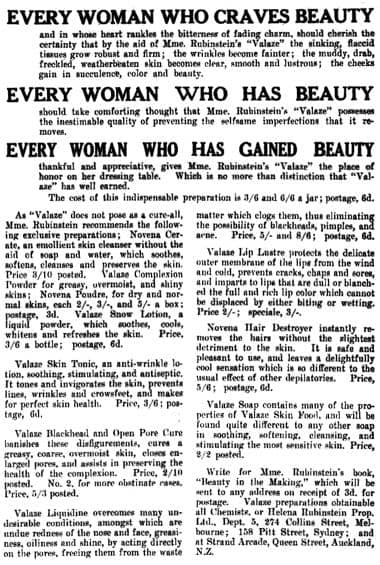
1914 Helena Rubinstein assorted products.

1914 Helena Rubinstein product list. Although the derivation of the word Valaze is unknown – despite numerous claims to the contrary – the Novena name may be derived from the Hungarian word Növény which means plants.

1914 Helena Rubinstein freckle treatments.
